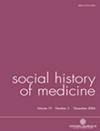“日光的浪费”:节律、工人健康和英国爱德华时代的日光节约时间法案
IF 0.7
2区 哲学
Q1 HISTORY
引用次数: 1
摘要
本文探讨了时间、健康和现代历史上的一个有趣事件:英国1908年和1909年的日光节约时间(DST)法案。虽然最初的夏时制计划没有成功,但围绕其实施的讨论揭示了20世纪早期现代性的核心紧张关系,即工业时间与“自然”身体节奏之间的紧张关系。这篇文章认为,夏令时本质上是一项公共卫生措施,旨在通过政府对劳动阶级的私人时间的管制,改善店员和店员等室内工人的条件。根据提供给两个下议院特别委员会的大量证据,这篇文章揭示了夏令时辩论如何将围绕阳光疗法、夜间工作以及规律睡眠和饮食的重要性的当代讨论结合起来,以解决英国的地方性城市疾病,如消费和贫血。我认为,在这一时期,身体节律的概念在医学思想中越来越重要,对节律性的研究表明,有可能将暂时性纳入医学史的分析范畴。本文章由计算机程序翻译,如有差异,请以英文原文为准。
‘The Waste of Daylight’: Rhythmicity, Workers’ Health and Britain’s Edwardian Daylight Saving Time Bills
Summary This article explores an interesting episode in the history of time, health, and modernity: Britain’s 1908 and 1909 Daylight Saving Time (DST) Bills. While the original DST scheme was unsuccessful, the discussions surrounding its implementation reveal tensions central to early twentieth century modernity, namely between industrial time and ‘natural’ bodily rhythms. This article argues that DST was essentially a public health measure aimed at improving the conditions of indoor workers like shop girls and clerks through government regulation of the private time of the labouring classes. Drawing on the extensive evidence provided to two House of Commons Special Committees, this article reveals how DST debates drew together contemporary discussions around sunlight therapy, night work, and the importance of regular sleeping and eating to tackle Britain's endemic urban diseases like consumption and anaemia. I suggest that the idea of bodily rhythms was increasingly important in medical thinking in this period and that the study of rhythmicity points to the potential for incorporating temporality as an analytical category in medical history.
求助全文
通过发布文献求助,成功后即可免费获取论文全文。
去求助
来源期刊

Social History of Medicine
社会科学-科学史与科学哲学
CiteScore
1.60
自引率
0.00%
发文量
63
审稿时长
>12 weeks
期刊介绍:
Social History of Medicine , the journal of the Society for the Social History of Medicine, is concerned with all aspects of health, illness, and medical treatment in the past. It is committed to publishing work on the social history of medicine from a variety of disciplines. The journal offers its readers substantive and lively articles on a variety of themes, critical assessments of archives and sources, conference reports, up-to-date information on research in progress, a discussion point on topics of current controversy and concern, review articles, and wide-ranging book reviews.
 求助内容:
求助内容: 应助结果提醒方式:
应助结果提醒方式:


